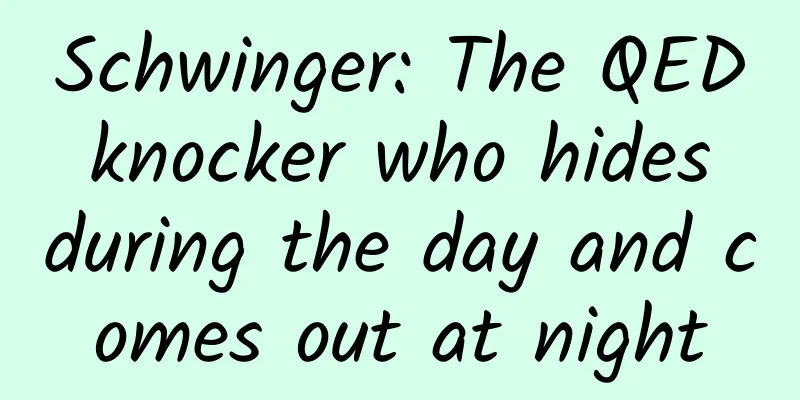Schwinger: The QED knocker who hides during the day and comes out at night

|
Schwinger is a low-key genius physicist. Yang Zhenning once commented on him: "Shy, erudite, speaking refined and fluent English, Schwinger is a symbol of cultural perfectionism, a very introverted master." Schwinger is not as famous as Feynman, but they are both top physicists of that era (they were born in the same year). As the founders of quantum electrodynamics, they shared the 1965 Nobel Prize. Schwinger also trained a large number of outstanding students, including 4 Nobel Prize winners. Of course, he is also quite individual - in the days when he is active at night, he gives physics a little "little precision". Written by | A string In January 1948, the American Physics Annual Meeting was held at Columbia University. A young man in formal suit and neatly combed hair gave a report entitled "The Latest Progress in Quantum Electrodynamics" at the meeting. Obviously, the audience did not agree with the idea of only giving such a wonderful academic report once. Amidst the cries of "One more time", the young man was asked to move to the largest classroom in the Physics Department to give his speech again. Not long after, the American Physical Society arranged for the young man to speak in the largest auditorium of Columbia University. Many audiences came to the auditorium to attend the lecture, and the auditorium was packed. In this enthusiastic atmosphere, the young man had to give his report again. The young man who completed the "hat trick" at this physics event was Julian Schwinger, one of the founders of quantum electrodynamics (QED). Schwinger giving a speech Child prodigy and mentor Julian Schwinger was born on February 12, 1918, into a Jewish family in New York. His parents were clothing merchants who immigrated from Poland to the United States. Julian had an older brother, Harold, who was seven years older than him and later became a lawyer. Schwinger had admired his brother very much since he was a child. Perhaps because of Julian's gentle and taciturn personality, people who knew the brothers generally believed that Harold was smarter than Julian, and this view did not change even after he won the Nobel Prize. The Great Depression in the United States in 1929 had a huge impact on the Schwinger family, and the once wealthy family began to go downhill. Once, young Julian cried loudly on the street because he had no money to take the bus, and was finally sent home by a kind person. Schwinger showed amazing talent at a very young age. He skipped grades and entered Townsend Harris Public High School in 1932. Apparently, this "Renmin University High School" in Queens, New York, adhered to the tradition of "if you don't study hard, go next door": the City College of New York accepted all graduates of Townsend Harris High School and provided full scholarships. In this way, Schwinger, who graduated from high school in 1934, entered the City College of New York. Soon, he published his first academic paper. That year, Schwinger was 17 years old. If you imagine Schwinger as a good student in the traditional sense, you are totally wrong. In fact, after entering university, Schwinger soon began to live a life of day and night reversal (this work and rest pattern accompanied Schwinger throughout his life). Schwinger almost never went to class, and his academic performance could not be said to be among the best, but at least it was a mess. Of course, Schwinger did not stay up at night to play games (there was no such thing at that time) or go to bars for fun, but to study cutting-edge physics papers. Soon, Schwinger met the mentor who influenced his life. Schwinger's brother Harold had a roommate named Lloyd Motz. At the time, Motz was studying for a doctorate at Columbia University and was teaching at the City College of New York to earn extra money. Motz later became an astronomer. With the introduction of his brother, Motz met Schwinger. Motz saw that Schwinger had a unique temperament, so he often brought Schwinger with him when he attended academic lectures at Columbia University. Once, Isaac Rabi (1944 Nobel Prize winner in Physics) saw Schwinger sitting in silence in the last row and curiously asked Motz, "Did you bring this kid who always dozes off in the back row?" Motz said, "Yes, this kid is a talent." (By the way, you may not be familiar with Rabi, but you must have heard of the MRI in hospitals, the basic principle of which was discovered by Rabi.) Rabbi (Isidor Isaac Rabi, 1898-1988) Once, Rabi was arguing with others in the corridor about the EPR paradox that Einstein had just published. Several people found that one of the physical quantities was not calculated correctly. Schwinger, who happened to be passing by, stopped, listened for a while, and said to Rabi: "This is simple, it can be solved using the completeness of quantum mechanics." Several people calculated the correct result according to Schwinger's guidance. Rabi, who had a keen eye for talent, immediately realized that Schwinger was a rare talent. He loved talents like his life and made up his mind to transfer Schwinger from City College to Columbia University. But when transferring, Rabi encountered trouble. The trouble Rabbi encountered was simple - Schwinger's transcript was so bad that the people at City College agreed to let him go, but Columbia University didn't want to accept him. Rabbi had to go to Columbia University's admissions office to argue. He vented to the admissions office and wanted the admissions office to recruit Schwinger as a baseball student, but it didn't work. In desperation, Rabbi took Schwinger to find Hans Bethe (Nobel Prize in Physics in 1967), who was visiting Columbia University at the time, and showed him Schwinger's unpublished article. Soon Bethe wrote a long letter of recommendation for Schwinger. At the end of the letter, Bethe predicted that Schwinger would become an outstanding physicist in the future. With Bethe's reputation and prestige in the physics community, Schwinger got the opportunity to transfer and received a scholarship. Columbia University Years In this way, in September 1935, Schwinger began his study at Columbia University. The rabbi gave Schwinger three rules, asking him to study hard, stop skipping classes, and strive to be a "three-good student". In the first few weeks, Schwinger obeyed obediently. But not long after, Schwinger forgot the rabbi's advice and returned to his original biological clock. Schwinger hated experimental physics and some irrelevant courses, thinking they were boring things that hindered his study of physics. In order to skip classes, Schwinger simply postponed the time of getting up again and again, until 6 pm when all classes were over. When Schwinger graduated from college, the rabbi strongly recommended him to win the Phi Beta Kappa Award (almost the highest honor for undergraduates in the United States), but everyone opposed it because of his terrible transcript. Just as the rabbi was arguing with the scholars, the department head stopped the debate with one sentence: "Who among you has published more papers than Schwinger in the past two years?" In the end, everyone agreed to give the award to Schwinger. Two or three years after entering Columbia University, Schwinger submitted an application for a doctoral dissertation defense, but was rejected by the school. Unlike many doctoral students who were rejected because of insufficient number or quality of articles, Schwinger had already published more than 10 academic papers and had completed his doctoral dissertation long ago. The school rejected Schwinger's doctoral degree because he had not completed the required credits. In fact, during his time at Columbia, Schwinger went from skipping classes to simply not taking final exams. Schwinger's predicament reached the ears of George Uhlenbeck. Uhlenbeck was one of the originators of the concept of electron spin (he was nominated for the Nobel Prize several times but unfortunately did not win). In 1938, he was invited from the Netherlands to New York, USA, to be a visiting professor at Columbia University, where he taught statistical mechanics. Schwinger took this course (to make up credits), and as usual, he never attended a class. Uhlenbeck admired Schwinger's talent. After he learned that Schwinger could not get a doctorate, he took the initiative to find Rabi and said to him: "I teach the class anyway, so just give Schwinger an A, so that he can get credits." Rabi loved talents, but he also adhered to principles and did not agree with Uhlenbeck's proposal. He said to Uhlenbeck: "Please prepare a separate oral exam for him. He can answer the most difficult questions." The oral exam was originally scheduled for 8 a.m., but it was postponed to 10 a.m. because Schwinger could not get out of bed. After the oral exam, Uhlenbeck was amazed - Schwinger not only answered all the questions, but also used the same method as Uhlenbeck, as if Schwinger had never missed the class. Of course, not all teachers appreciated Schwinger's talent as much as Uhlenbeck did. There was a chemist named Victor LaMer who used a symbol system of his own invention in all classes and exams. Schwinger, who had never attended class, suffered a great loss and was given an F (Failed). After Schwinger became famous at the American Physics Annual Meeting in 1948, Rabi met LaMer while walking with his colleagues. Rabi deliberately said to his colleagues: "There is a person who is really amazing. He was asked to do the same report three times." Finally, Professor LaMer asked, "Who is this person?" Rabi seized the opportunity and immediately said: "Oh, you know this person, his name is Schwinger, the student you gave him an F." Perhaps because of his disgust for the rigid credit system, Schwinger said, when recalling his years at Columbia University, that he learned almost nothing there and that he had already mastered enough knowledge before entering. In 1939, Schwinger (who finally got enough credits) defended his thesis entitled "On the magnetic scattering of neutrons" and obtained his doctorate degree at the age of 21. Of course, Schwinger's doctoral supervisor was a rabbi. pacifist After graduating with a Ph.D., Schwinger went to the University of California, Berkeley, to do research under JR Oppenheimer. In 1941, Schwinger joined Purdue University. As the United States was drawn into World War II at the end of 1941, the lives of the American people were more or less affected, and Schwinger was no exception. It is not difficult to see from the title of Schwinger's doctoral thesis that Schwinger's research at Columbia University was mainly focused on nuclear physics. From 1941 to 1945 in the United States, basically everyone who had anything to do with physics was pulled to Los Alamos to work on the atomic bomb, and people with professional expertise like Schwinger should have participated in it. But when Schwinger learned that the Manhattan Project was "making a destructive weapon", the peace-loving him decided to go to the Massachusetts Institute of Technology (MIT) Radiation Laboratory to study radar. After all, radar is a defensive technology, which is a kind of inner comfort for the pacifist Schwinger. I'm afraid Schwinger himself didn't expect that it was this choice that changed his life-the mathematical methods he developed while working in the radar laboratory to calculate complex antenna systems played a big role in the renormalization of quantum electrodynamics. During his time at the MIT Radiation Laboratory, Schwinger became the leader of the theoretical group with his solid mathematical and physical knowledge. However, being a leader did not change Schwinger's habit of sleeping during the day and going out at night. He still got up at 6 o'clock in the afternoon, discussed some problems with his colleagues during dinner, and then went to the laboratory to work alone. During the day, when his colleagues came to the laboratory, he went home to sleep. Since they rarely met him, colleagues who wanted to ask him questions could only do so by "leaving notes" - they wrote their questions on sticky notes and left them on Schwinger's seat, and the colleagues who asked questions would always receive satisfactory answers the next morning. According to legend, once a young man left a note asking a question about the properties of Bessel functions. A few days later, he received an answer from Schwinger at his workstation - a 40-page calculation manuscript. The young man was very depressed, but he still worked on it bit by bit. Halfway through, he found that the result of his calculation was different from what Schwinger wrote. Schwinger was famous for his good mathematics, and the young man thought he had made a mistake. After another week of calculations, the young man's results still did not match the results in the calculation manuscript. Later, the young man plucked up the courage to find Schwinger (maybe he had to wait until Schwinger came to the laboratory at night), and Schwinger found that he had made a mistake. He stuck out his tongue and said embarrassedly: "This paragraph was copied from a certain book. It seems that books cannot be trusted. I would have deduced it myself if I had known." In order to allow Schwinger to communicate more with his colleagues, the director of the Radiation Laboratory stipulated that a seminar be held every week at 4:30 p.m. Schwinger had to get up two hours earlier to catch up with the seminar. Every week at 4:30 p.m., everyone would see Schwinger running into the conference room out of breath, which was a unique sight in the Radar Laboratory. After the end of World War II, in 1945, Schwinger did not choose to return to Purdue University. He came to Harvard University and began another research career. Schwinger went to Harvard to seek a teaching position. It is said that he competed with Hans Bethe, who wrote a letter of recommendation for him. In the end, Schwinger won. I don't know what Bethe felt at the time (I feel sorry for old Bethe for a minute). QED Knocker In June 1947, a group of people in suits and ties gathered in a small town called Shelter Island on the eastern end of Long Island, New York, breaking the long-lost tranquility here. Since most of the people who came had participated in the Manhattan Project, the residents of the town were rumored that the US military was going to do something big again. The reality was that they were here to hold a meeting to discuss fundamental issues in quantum mechanics, which had nothing to do with weapons manufacturing. Schwinger commented jokingly on the meeting: "This is the first time in five years [since the Pacific War] that physicists can discuss problems freely without being monitored." A group photo of the Shelter Island Conference participants. The person in the middle holding the left hand with his right hand is Schwinger. In the history of the development of quantum mechanics, the Shelter Island Conference is as important as the highly famous Sowell Conference, which directly led to the emergence of quantum electrodynamics (QED). Specifically, there were two important experimental results at this conference that attracted the attention and attention of theoretical physicists. The first was an important experimental discovery reported by Willis Lamb: The energy difference is 2.0011597. According to Dirac's theory, these two energy levels are strictly degenerate (this experimental result is called the "Lamb shift"). The second is that Rabi reported the newly discovered electron magnetic moment, whose Lande g factor is 2.0011597, but Dirac's theory shows that the Lande g factor corresponding to the electron magnetic moment is exactly equal to 2. This phenomenon was later called the anomalous magnetic moment of the electron. After the meeting, Schwinger did not start his research, but went on a three-month honeymoon (the Shelter Island meeting was held a week before Schwinger got married). After the honeymoon, Schwinger devoted himself to long and complex calculations, using the method of redefining charge and mass (this method is called "renormalization" today) to obtain the results of Lamb shift and anomalous magnetic moment of electrons, which were highly consistent with the experiment. From the perspective of modern field theory, Schwinger's calculation essentially corresponds to a circle in the Feynman diagram. Today, the calculation of a circle has almost become a required course for high-energy physics graduate students studying quantum field theory. Schwinger did not have a Feynman diagram. He relied on perturbation theory to calculate all the terms one by one. People were amazed at Schwinger's calculation ability - there was not a single mistake in such a long calculation. This is Schwinger's most classic photo. The caption on the photo is "His laboratory is his ballpoint pen." Another indisputable fact is that Schwinger's method is the orthodox thinking in the physics world. Although Feynman had already published the Feynman diagram technique at that time, people at that time could not accept these doodles that looked more like graffiti drawn to guess the answers to the questions. Even Feynman himself could not explain the origin of the Feynman diagram calculation rules (that is, Feynman rules). This embarrassing situation was not broken until October 1948: Freeman Dyson (an absolute tough guy) completed "The Radiation Theories of Tomonaga, Schwinger, and Feynman", proving the equivalence of the theories of Schwinger, Tomonaga Shin'ichirō (1906-1979) and Feynman. Only then did people gradually begin to accept the strange-looking Feynman diagrams. The 1965 Nobel Prize in Physics was awarded to Schwinger, Richard Feynman and Japanese physicist Shin'ichirō Tomonaga in recognition of their fundamental contributions to quantum electrodynamics. To be fair, Schwinger's Nobel Prize was a foregone conclusion, and Feynman and Tomonaga really had to thank Dyson for winning the Nobel Prize. Future generations of physicists also have to thank Dyson. If there were no Feynman diagrams, the books on field theory would be at least three times thicker than they are now. Still from the TV series "The Big Bang Theory": Several people drive a truck covered with Feynman diagrams. Schwinger himself never used Feynman diagrams in his published articles, and he did not allow his students to use Feynman diagrams in his research group, but his students once discovered that Schwinger secretly used Feynman diagrams (The True Fragrance Theorem). It is no exaggeration to say that Schwinger was a central figure in physics research in Europe and the United States in the 1940s and 1950s. Throughout his life, Schwinger mentored more than 70 doctoral students, four of whom later won the Nobel Prize, including three physics winners and one chemistry winner. They are: Glauber (Roy Jay Glauber, 2005 Nobel Prize in Physics), Mottelson (Ben Roy Mottelson, 1975 Nobel Prize in Physics), Glashow (Sheldon Glashow, 1979 Nobel Prize in Physics) and Kohn (Walter Kohn, 1998 Nobel Prize in Chemistry). Non-mainstream physicists After achieving great success in quantum electrodynamics, Schwinger came up with the idea of rewriting the QED theory, which is the so-called Source theory. However, Schwinger's idea ultimately failed to take shape. In 1972, Schwinger resigned from Harvard and moved to UCLA to teach. After leaving Harvard, Schwinger's research began to move further away from the mainstream physics community. In 1989, Schwinger became fascinated with cold fusion and wrote eight articles in a row to discuss his research on cold fusion. However, the articles were rejected for publication. The reviewer wrote in the rejection letter, "No nuclear physicist would believe the effects mentioned in the paper." Schwinger responded directly, "I am a nuclear physicist!" The insulting rejection letter made Schwinger believe that the spirit of academic freedom was no longer there, and in anger he withdrew from the American Physical Society. Schwinger's epitaph On July 16, 1994, Schwinger died of pancreatic cancer in Los Angeles at the age of 76. His tombstone is engraved with α/2π, which corresponds to the anomalous magnetic moment of the electron, indicating that the person buried here was the first to give such an accurate calculation result. For Schwinger, who loved mathematics all his life, such a concise epitaph may be the best footnote of his life. References [1] Wikipedia: Schwinger, [2] Introduction of Schwinger on the Nobel Prize official website: https://www.nobelprize.org/prizes/physics/1965/schwinger/biographical/ [3] Julian Schwinger Biography - Childhood, Life Achievements & Timeline [4] Professor Gao Chongwen of Chung Yuan Christian University in Taiwan wrote an article in memory of Schwinger: "Xu Wen-ge, a genius physicist who submitted 14 papers at the age of 21 and worked day and night, [5] http://scihi.org/julian-schwinger/ This article was originally published on Zhihu and was reprinted on Fanpu with the author’s permission, with slight modifications. About the Author A string. I am not an outstanding graduate of Zhongguancun University of Arts and Sciences. During my doctoral studies, I mainly developed the theory of collective excited states of atomic nuclei, and I also got gossip news as a side job. Due to the high housing prices in the capital and the mistrust of rumors of high salaries in IT, I mistakenly became a programmer and fled Beijing to Hangzhou, the capital of the world. In addition to my full-time job, I explore and write about physicists on Zhihu and Bilibili under the usernames "A String" and "A String Fat Er", and I enjoy it. Special Tips 1. Go to the "Featured Column" at the bottom of the menu of the "Fanpu" WeChat public account to read a series of popular science articles on different topics. 2. Fanpu provides a function to search articles by month. Follow the official account and reply with the four-digit year + month, such as "1903", to get the article index for March 2019, and so on. Copyright statement: Personal forwarding is welcome. Any form of media or organization is not allowed to reprint or excerpt without authorization. For reprint authorization, please contact the backstage of the "Fanpu" WeChat public account. |
<<: It’s time to go to Gannan!
Recommend
Elegant skeuomorphic progress bar control
Source code introduction: An elegant and fresh pr...
The stay-at-home economy opens a new era of TV marketing, and Coocaa Technology leads OTT marketing into the second half
As the OTT marketing industry continues to evolve...
Recommendations for investment in major industries during the epidemic, for reference!
The novel coronavirus epidemic that has swept acr...
Be careful! Don’t let the windows of your soul have holes
today #22-year-old girl preparing for postgraduat...
Coffee causes cancer? Don’t panic! This article will help you sort out the love-hate relationship with coffee
Coffee originated in the Kaffa region of Ethiopia...
Are you still worried about the advertising materials for Moments? Here is a complete design specification!
1. Copywriting Copywriting is an important part o...
iOS9 Learn more every day 3 :: Storyboard References
[[142029]] If you have ever used interface builde...
33 data points on Apple in 2014
[[125219]] The technology industry continued to c...
Don't sit for too long, this position will sink! 2 ways to improve it → (with illustrations)
Every time I see someone's peach buttocks, I ...
Have a happy winter vacation, stay safe! @Every parent and child, please check the winter vacation safety tips
As the Spring Festival approaches, many children ...
What functions can be achieved by developing WeChat applet for tourist attractions?
As people's living standards improve and they...
Why do forest fires occur more frequently in spring? The culprit of spring fires is actually here →
...
Fengxing intends to expand its super-dimensional ecosystem; investment alliances in the color TV industry have become a trend
"12 million units shipped in 3 years". ...
Help! It’s so hard to get up in winter… How can I get up quickly and painlessly?
Planning and production Source: Curious Doctor Ed...
Apple releases iOS 14.1 and iPadOS 14.1 with multiple bug fixes
Apple today released iOS and iPadOS 14.1, the fir...









